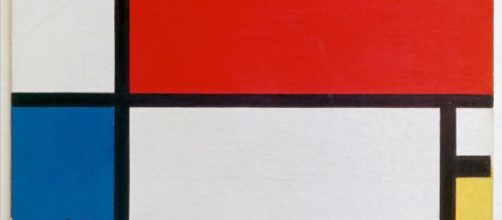It’s hard to believe that an artist who started out painting allusive, impressionistic landscapes like “Meandering Landscape with River” would end up pioneering a style that barred any kind of meandering.
Instead, this artist made a dead stop at painting strictly geometric grids of straight, unbroken black lines enclosing spotless primary colors. Elemental, thy name is Piet Mondrian, who made history in the 20th century by advancing the art of abstraction painting.
And just as Mondrian made history in the early part of the last century, he’s doing it again in this century.
This time a sale of his “Composition No. II” at Sotheby’s, NY is expected to break all auction records for him – “in excess of $50 million,” according to Art News magazine.
It's notable that in 1983 this very same painting sold at auction for $2.2 million – at the time the highest price for Mondrian. Why, one may wonder, has the value of his work soared 20 times higher now?
I think the answer is the same as the one to the question, why did he turn from landscape painting to abstraction: the chaos of modern life.
Consider this: Mondrian painted “Composition No. II” in 1930 when the U.S. was going through the Great Depression and Nazi Germany was on the rise in Europe.
Our times today are no less chaotic.
America’s democratic way of life is under attack and Vladimir Putin threatens the use of nuclear weapons.
Peace on earth
I think chaos drove Mondrian to seek order and a kind of purity, and I think today’s art collectors seek the same relief.
I rush to say that Mondrian’s geometrics while supremely ordered are not without life. He enlivened his pictures through the drama of contrast. The tension between line and shape, between the vertical and horizontal direction of the lines, and between the colored squares and black lines. But he did the enlivening with a precision that provides what, a kind of visual comfort?
But wait. We don’t have to wonder what Mondrian was thinking. He was so intent on abstract painting that he wrote nearly 100,000 words on the subject.
And given what he said, my theory has holes in it.
He didn’t see his strict-looking style as an escape from chaos. He saw it as an escape from nature, from landscapes. "Lines and colors," he wrote, "must be freed from their bondage to the imitation of nature and allowed to exist for themselves."
Clearly, Mondrian believed painting that captured nature was a waste of his time. Margaret Barr quoted him saying in The New Criterion, “Nature is a damned wretched affair.”
The “wretched affair”
An incident recounted in Donald Hall and Pat Corrington Wykes 1990 book "Anecdotes Modern Art" demonstrates that Mondrian was a purist both in and outside his studio.
This tale comes from Nina Kandinsky, wife of abstract painter Wassily Kandinsky, who couldn’t get over Mondrian’s behavior when he visited them.
“It was on a glorious spring day,” she recalled. “The chestnut trees in front of our building were in blossom.” And in order to give their guest the best view, Kandinsky set out a chair for Mondrian facing the “flowering splendor” of the trees.
But that wasn’t what Mondrian wanted to look at and he turned his seat around to avoid seeing the flowering chestnut trees. Unlike fellow abstract painter Kandinsky, he took his disdain for nature even to garden parties.
As for my theory about the jump in auction price for “Composition No. II,” I’m sticking with it. People today need all the order they can get.


